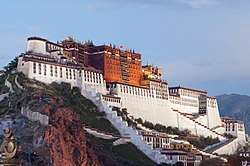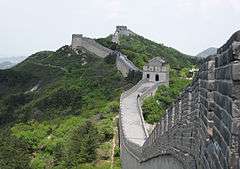East Asia
East Asia is the eastern part of Asia. It is sometimes described by the Eurocentric term Far East (which might also include Southeast Asia and the Russian Far East).
The region was the cradle of ancient civilizations such as the Imperial China, ancient Korea, ancient Japan and the Mongol Empire, and is today home to 1.6 billion people. The region contains world metropolises such as Tokyo, Seoul, Shanghai and Hong Kong, endless archipelagoes at the edge of the Pacific Ocean, as well as vast plains and sky-high mountains.
Countries and regions
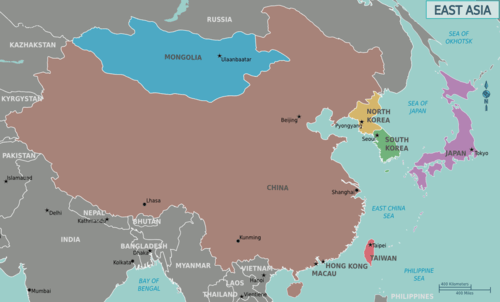
| China The world's most populous country and one of the oldest civilizations, with a vast array of cultural and natural treasures among the frenzied development. |
| Hong Kong This former British colony markets itself as Asia's World City. Come for the skyscrapers and shopping and still find beaches and sleepy villages on car-free islands. |
| Japan Isolated until the 19th century, Japan is today the world's third largest economy with both technology and tradition to offer. |
| Macau A former Portuguese colony with liberal gambling laws and beautiful colonial architecture in its UNESCO listed historical city centre. |
| Mongolia A nomadic land of vast spaces and mystic Buddhism. |
| North Korea The world's most secret society and last remaining outpost of the Cold War. |
| South Korea A hotspot of innovation and pop culture and in many ways the opposite of its northern neighbor. |
| Taiwan The remnants of the Republic of China, and an island of sharp contrasts: lush mountains, skyscrapers, gentle tai-chi and good food. |
- The Russian Far East might be categorized with East Asia, but is part of Russia.
- While Vietnam is culturally associated with East Asia, it belongs to Southeast Asia geographically.
Cities
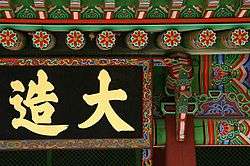
- 🌍 Beijing — surviving five dynasties, the Communist Revolution, and the Cultural Revolution, over 800 years of ancient cultural sites can be found throughout this very modern city
- 🌍 Hong Kong — Cantonese-Chinese port city with a long British heritage crowned by Victoria Peak
- 🌍 Kyoto — ancient capital of Japan, considered the cultural heart of the country, with many ancient Buddhist temples and gardens
- 🌍 Shanghai — the main business center in China; an ultramodern, cosmopolitan metropolis with a fascinating mix of East and West
- 🌍 Pyongyang — dominated by some of the most dystopian communist architecture
- 🌍 Seoul — beautiful palaces, great food and a hopping nightlife, Seoul is a frenetic way to experience the Asia of old and new
- 🌍 Taipei — center of government, commerce and culture of Taiwan, home to the world's second tallest skyscraper
- 🌍 Tokyo — a huge, wealthy and fascinating urban jungle with high-tech visions of the future side by side with glimpses of old Japan
- 🌍 Ulaanbaatar — the not-so-pleasant capital, but a starting point for most travel in Mongolia
Other destinations
- 🌍 Altai Tavan Bogd National Park - home to Mongolia's eagle hunters and highest mountain.
- 🌍 Great Wall of China (万里长城) — longer than 8,000 km, this ancient wall is the most iconic landmark of China
- 🌍 Mount Fuji — iconic snow-topped volcano, and highest peak in Japan (3776 m)
- 🌍 Panmunjeom — the only tourist site in the world where the Cold War is still reality
- 🌍 Tibet — mysterious place in the himalayas with a unique local culture, considered by many to resemble the mythical Shangri-La
- 🌍 Seoraksan National Park — South Korea's most renowned national park and mountain range
- 🌍 Taroko Gorge
- 🌍 Yakushima
- 🌍 Yungang Grottoes
Understand

East Asia, also popularly known as "the Far East" (especially when compared with the other "East", the Middle East) is the core of what used to be known in the West as The Orient, supposedly a mysterious land inhabited by a race of inscrutable tea-sipping Orientals. Behind the caricature, though, is a uniting factor in the form of Chinese influence: China, as by far the largest and, historically, the most technologically and societally advanced culture in the region, has given its writing system (Chinese characters), religion (Mahayana Buddhism) and philosophy (Confucianism) to all the countries in East Asia.
However, underneath these superficial similarities lie a vast range of differences. The geography alone covers the gamut, from the arid steppes of Mongolia to the vast deserts of northwestern China, the lush rice paddies of south central China and the beaches of the subtropical islands of Okinawa. The upheaval of the past centuries has also led the countries of the region along strikingly different paths, with the hyper-modern skyscrapers and consumerist culture of Japan having little if anything in common with the Stalinist austerity of North Korea.
Despite the unifying factor of Chinese influence, scratch below the surface and you will find a wide range of cultural differences. In China, even within the "Han Chinese" community, the local customs, traditional architecture and cuisine vary widely from region to region, and people native to one region may find certain customs from other regions entirely foreign. In addition, the respective ethnic minorities also practise their own local customs. While the traditional cultures of Korea and Japan have obvious Chinese influences, they still retain many native elements which make them unique in their own right.
History
- See also: Imperial China, Mongol Empire, Pre-modern Japan, Pre-modern Korea, Pacific War
East Asia was one of the cradles of world civilisation, with China developing its first civilisations at about the same time as Egypt, Babylonia and India. China stood out as a leading civilisation for thousands of years, building great cities and developing various technologies which were to be unmatched in the West until centuries later. The Han and Tang dynasties in particular are regarded as the golden ages of Chinese civilisation, during which China was not only strong militarily, but also saw the arts and sciences flourish in Chinese society. While the Mongol Empire under Kublai Khan conquered China, the invaders were assimilated into Chinese culture and became the Yuan dynasty. Chinese It was also during these periods that China exported much of its culture to its neighbours, and till this day, one can notice Chinese influences in the traditional cultures of Vietnam, Korea and Japan.
Korea and Japan had historically been under the Chinese cultural sphere of influence, adopting the Chinese script, and incorporating Chinese religion and philosophy into their traditional culture. Nevertheless, both cultures retain many distinctive elements which make them unique in their own right.
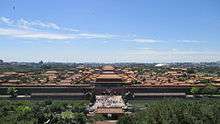
However, Chinese dominance was to end during the 19th century, when Western powers arrived and forced the various East Asian states to sign unequal treaties. It first started with Commodore Matthew Perry of the United States forcing Japan, which had adopted an isolationist policy for centuries, to open up to the West, which eventually resulted in collapse of the Tokugawa Shogunate and started the Meiji restoration. China was also not spared from Western imperialism, and by then, government corruption had reduced what once was one of the world's greatest civilisations to a sorry state. As a result, China lost several wars to the Western powers as well as its newly modernised neighbour, Japan. As a result of these wars, China lost Hong Kong and Weihai to Britain, while Taiwan, Manchuria and the Liaodong peninsula were ceded to Japan. China also lost control of its tributaries, with Vietnam being annexed by the French, and Korea and the Ryukyu Islands being annexed by the Japanese. Shanghai was also divided among eight different countries (France, Germany, Italy, the United Kingdom, the United States, Russia, Austria-Hungary and Japan).
World War II was to have disastrous consequences on East Asia, as Japan's drive to modernise turned into a drive to colonise its neighbours. The war brought great suffering to many, and destroyed much of East Asia's infrastructure. Japan was also not spared, as much of the nation was destroyed by American carpet bombing, and the cities of Hiroshima and Nagasaki destroyed by atomic bomb attacks. Japan's defeat after World War II forced it to give up its colonies, with Taiwan being returned to China, and Korea regaining its independence. However, the end of the war was anything but peaceful. The Chinese Civil War continued, which resulted in victory for the communists, led by Mao Zedong, giving them control of much of the mainland, and the nationalists, led by Chiang Kai-Shek, forced to retreat to the island of Taiwan and several offshore islands of Fujian, where they remain in control to this day. Korea was split after World War II, with Kim Il-Sung establishing a communist regime in the north with the support of the Soviet Union, and Syngman Rhee establishing a capitalist regime in the south with the support of the United States. The Korean War began when Kim Il-Sung attacked the south. The war lasted for 3 years and had disastrous consequences, which ended with neither side making any significant territorial gains. North Korea and the United States signed an armistice in 1953 which ended the armed conflict, with South Korea refusing to sign, but no peace treaty was ever signed and the two Koreas remain officially at war with each other to this day.
Despite decades of turmoil, East Asia has begun to grow into one of the most prosperous and technologically advanced regions in the world. Japan was the first to rise from the ruins of World War II, rapidly modernising in the 1950s-1960s and eventually conquering the world's marketplaces with its automobiles and advanced consumer electronic products to become the world's second largest economy after the United States. This was followed by the rise of the Asian Tigers, which included South Korea, Taiwan and Hong Kong, who overcame war and poverty to achieve unprecedented growth rates during the 1970s-1980s, earning their places among the world's richest economies. Today, South Korea and Taiwan are among the world leaders in consumer technology, while Hong Kong remains a leading financial center of the world.
.jpg)
More changes were to come at the end of the 20th century. The death of Mao Zedong resulted in the end of the disastrous Cultural Revolution. After a brief power struggle with Mao's appointed successor, Hua Guofeng, Deng Xiaoping emerged victorious and abandoned a hardline Communist policy to introduce market-oriented reforms, which have transformed China into one of the world's fastest growing economies. China overtook Japan to become the world's second largest economy in 2009. In the 1990s, the British and Portuguese colonies of Hong Kong and Macau were returned to Chinese rule (albeit under special administration status). While the larger cities near the coast like Beijing, Shanghai and Guangzhou have grown to become rich and modern, much of the country still suffers from poverty and China's former leader Hu Jintao has pledged to modernize the more inland parts of the country, though whether or not China can rise from the ashes to achieve its past glories during the Han and Tang dynasties remains to be seen. Pretty much the only exception to East Asia's economic success is North Korea, which has refused market-oriented reforms and continues to adopt a hardline Stalinist policy to this day.
Talk
Japanese, Korean and Mongolian are distinct and dominant languages spoken in their respective countries. There are no other languages widely spoken in Japan and South Korea, although English is generally learnt in school by most people. Russian is often spoken as a second language in Mongolia.
The situation in China is more complicated, with Mandarin being the official main language with many dialects being not mutually intelligible such as Cantonese and Hokkien. Extensive travel in China will be very much helped by learning some phrases of Mandarin, since almost everyone will at least understand the basics of that language. Learning another dialect, although appreciated, will not be of great use outside of its immediate area. Bear in mind that the tonal aspect of each Chinese dialect is also difficult to master. In addition, China is home to many ethnic minorities who speak various non-Chinese languages.
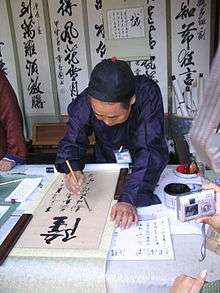
Chinese characters are used throughout China and Japan, although even these can have wide differences between the countries. (The characters 手紙, literally "hand paper" and meaning "letter" to the Japanese, would be taken as "toilet paper" in China, for example.) They are also used to a much lesser extent in South Korea, where they occasionally appear in newspapers, as well as in official government and academic documents.
Japanese and Korean are not directly related to Chinese, but both languages are dominated by Chinese loan words due to the long history of Chinese cultural dominance in the region. Due to American influences in Japan and South Korea since the end of World War II, the Japanese and (South) Korean words for many modern concepts are derived from American English. North Korean rejects English loan words for obvious reasons.
Taiwan uses mainly Mandarin and Hokkien. Hong Kong and Macau use Cantonese, although many people these days can also speak English and Mandarin there as well. However, the usage of Mandarin in Hong Kong may be frowned upon in some instances due to the rise of socio-political tensions between the territory and Mainland China, as well as associations of the language with the communist Chinese government and its attempted policies of trying to limit the use of Cantonese. Despite having been a Portuguese colony for over 400 years, Portuguese is not widely spoken in Macau, though government offices and public venues are required by law to have Portuguese-speaking staff on duty, and all official government signs are bilingual in Chinese and Portuguese.
Overall, English remains a traveler's most useful language and is taught in school in all countries. In practice, it is easy to find advanced English speakers in the former British colony of Hong Kong, but otherwise you may have difficulty finding people who speak it. It is worth noting that many people in East Asia have a much easier time reading and writing English than speaking it.
Get in
By plane
The main intercontinental gateways to East Asia are Hong Kong (HKG IATA), Tokyo (NRT IATA & HND IATA; TYO IATA for all airports), Seoul (ICN IATA), Shanghai (PVG IATA), Beijing (PEK IATA), Guangzhou (CAN IATA) and Taipei (TPE IATA). However, there are also many other cities with connections to other parts of Asia, which can be convenient entry points for certain travelers. Transferring through mainland China, though increasingly an option in terms of flights, is painful and time-consuming (you may also require visas) and best avoided. If arriving from Europe, transiting via Bangkok or Singapore-Changi in South-East Asia may prove cheaper than a direct flight.
By train
The Trans-Siberian Railway connects Russia to Mongolia and China, and China is linked to Vietnam with the jointly operated Kunming and Nanning to Hanoi routes. Another increasingly popular alternative is going via Central Asia and take the twice weekly service between Almaty in Kazakhstan and Urumqi in China, a journey of around 31 hours dubbed the "new silk route". There is a rail link from Russia (Khasan) into North Korea (Tumangang), with regular trains running from Moscow to Pyongyang, though in practice using this route is difficult if not next to impossible for western tourists, and is generally only available for North Korean and Russian citizens.
By bus
The Karakoram Highway connects Pakistan to China, it is the highest border crossing in the world. The Irkeshtam Pass and Torugart Pass connect Kyrgyzstan with China via the ancient Silk Road.
By boat
It's possible to take ferries from the Russian Far East to Japan and Korea, try Heartland Ferry (Korsakov - Wakkanai) and Fesco (Vladivostok - Toyama) for the easiest options.
Cruise ships also operate between Southeast Asia and East Asia, with several sailings from Singapore to Hong Kong, and occassionally even as far afield as Yokohama.
Get around
Travelling in North Korea is only possible as part of a state-sanctioned guided tour, and any form of independent travel is generally banned for visitors, who will be watched closely and placed under heavy restrictions. Other countries in East Asia present many options to travellers for travelling around and between them, though transportation infrastructure ranges from very convenient and well-developed in Japan and South Korea to somewhat outdated and lacking in Mongolia.
By plane
Plane travel is the fastest way to travel between countries in East Asia, as well as long distances within them. Plane travel within China tends to be cheap by Western standards, although there is some governmental price regulation to keep the prices from being too low. Most flights include meals, which can range from boxes with assorted snacks to steaming hot meals. Vegetarian, halal or kosher meals are usually not available at short notice, but may be available if you make arrangements with the airline well in advance. To be safe, check with the airline or your travel agent before you book your flights. Delays are common in some places (like China), sometimes by several hours.
Tokyo, Osaka, Seoul, Shanghai and Taipei each have two main airports; one close to the city centre for domestic flights and some short range international flights, and one far from the city for most international and intercontinental flights. Transferring from the domestic to the international airport and vice-versa can take up to two hours or more, depending on traffic conditions, so make sure you give yourself ample time to make any transfers.
By train
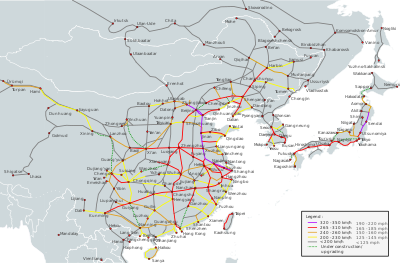
Japan, South Korea and Taiwan have extensive and modern train networks, but for reasons of geography and politics none of them connect to other countries. China also has an extensive network which is the main mode of long distance travel domestically. International services are available from China into North Korea and Mongolia, and there is also a rail link from mainland China into the Special Administrative Region of Hong Kong. Mongolia's railway network is restricted to a single line that passes through Ulaanbaatar on the way from Moscow to Beijing. North Korea's network, while relatively extensive, has outdated infrastructure and its use by tourists is generally forbidden, the exception being the line from Pyongyang to Beijing via Sinuiju. Although the railway networks between North and South Korea are physically connected, the political situation means that cross-border trains do not operate, and will likely not do so for the forseeable future.
Japan has a well-developed high-speed rail network known as the Shinkansen, which covers most of the country except Hokkaido (new line planned or under construction) and Okinawa. While Shinkansen are fast, clean safe and reliable, you will pay relatively high prices, even compared to similar trains in Europe. South Korea and Taiwan have begun to develop their own high-speed networks, known as the Korea Train Express (KTX) and the Taiwan High Speed Rail (THSR) respectively, with high-speed services along the main business corridors between Seoul and Busan in South Korea and between Taipei and Kaohsiung in Taiwan. China has also invested heavily its high-speed rail network, known as China Railway High-speed (CRH), in recent years, and now boasts the world's longest high-speed rail network, with connections between all the major eastern cities. Where high speed rail exists, it is usually the fastest mode of transport over short to middle ranges and often (though not always) beats flying in terms of price. Extremely long services without change of trains are only available in China, where some high speed trains have sleepers, but they are not as fast as a flight would be.
By bus
Bus travel is a popular cheaper option in East Asia, though in general somewhat slower than taking the trains, with many long distance bus routes connecting most cities domestically.
By car
Domestic travel by car is possible, though with the exception of Japan, and Hong Kong, driving habits and road courtesy are not up to the standards of the West which varies from annoying to outright reckless. Roads are generally well maintained, though snow can be a problem in the winter in the northern parts of Japan and China, with expressways often having to close due to heavy snow.
Those with no experience driving in big cities should generally avoid doing so in East Asia. East Asia is one of the most densely populated regions in the world, meaning that most of the major East Asian cities are plagued with massive traffic jams, coupled with expensive to non-existent parking spaces. These, combined with reckless driving habits, mean that exploring the cities by car is not for the faint hearted. East Asian cities have some of the best public transportation networks anywhere in the world, and you should try to use that as your main mode of transport.
Renting a car is usually the best way to see the countryside and smaller towns, although driving around Asia's mega cities are not for the faint of heart, and touring the likes of Tokyo, Shanghai or Taipei in a rented car is really considered a bad idea.
Traffic drives on the left in Hong Kong, Macau and Japan, and drives on the right everywhere else in this region.
By ferry
China has a good network of ferries for its internal river network as well as internationally to Japan, Taiwan, Hong Kong and Macau.
South Korea has a ferry network between the mainland and its many islands, most of which do not have airports. Ferries also depart for China and Japan.
Japan also has a domestic ferry network connecting its different islands. While rail service is available between Honshu and Hokkaido, this is restricted to passenger service, and the only way to transport a car between the islands is by ferry.
See

- China
- Stroll through Tiananmen Square and the Forbidden City in Beijing and then walk along the famous Great Wall
- Enjoy the iconic karst scenery in and surrounding Guilin in China's Guangxi Province
- Take a boat cruise on the Yangtze River
- Hike on the breathtaking Tibetan Plateau and enjoy the local culture in Western Sichuan and Northern Yunnan
- Stroll the Bund with a fabulous view of the Pudong skyscraper district in Shanghai
- Marvel at the scores of Terracotta Warriors in Xi'an
- Visit the historical sites along the old Silk Road in the Muslim/Turkic Xinjiang Province
- Ascend the hill to Potala Palace in Lhasa, Tibet and take the long bus ride across Tibet to Mt. Everest base camp
- Hong Kong
- Ride the tram up to Victoria Peak in Central Hong Kong
- Take a ride across Victoria Harbour on the famous Star Ferry to Kowloon for the best skyline views
- Climb 268 steps to the massive Tian Tan Buddha on Lantau Island
- Macau
- Admire centuries-old Portuguese architecture and ruins or test your luck at one of the numerous casinos of Macau
- Taiwan
- Ascend Taipei 101, once the world's tallest building, in Taipei
- Japan
- Ride the Bullet Train and stay in a capsule hotel or traditional ryokan
- Play Pachinko, vertical pinball
- Ride a cable car to Mount Aso, the world's largest caldera.
- Stroll through the manic neon world of districts like Shinjuku in Tokyo
- See the Peace Park in Hiroshima and the Peace Museum in Nagasaki
- Observe the probably-spewing-ash volcano in the bay of Kagoshima
- Korea
- Watch the Arirang Festival's Mass Games, said to be one of the most impressive performances in the world in Pyongyang, North Korea
- Visit the DMZ, the last frontier of the cold war in either North or South Korea
- Mongolia
- Witness Kazakh Eagle Hunters in action at the Golden Eagle Festival in Ölgii in Western Mongolia.
Itineraries
Do
Baseball
East Asia is the best place to experience baseball culture outside the Americas. The sport is hugely popular in Japan, South Korea and Taiwan, with professional leagues that often draw a full house of spectators. In fact, the baseball league in Japan is considered by many to be the best professional league outside the United States.
Pop culture

The entertainment industry is huge in East Asia, which has caused it to develop a distinctive pop culture scene. Famous pop stars often perform at concerts which attract sell-out crowds.
Hong Kong and Taiwan are the main centres of Chinese popular culture, with most famous singers and actors originating or based in the two territories. Due to the linguistic variation of the "Chinese language", in addition to Mandarin, songs may also be performed in Cantonese or Minnan. Due to stricter government controls, which include the banning of popular television programmes such as Super Girl, the pop culture scene is not as well developed in mainland China, though it is also slowly beginning to emerge, with several good quality wuxia series being produced in the mainland in recent times.
South Korea is a relative newcomer to the international pop culture scene, though the hallyu or Korean wave phenomenon at the turn of the millennium has sent waves across much of the continent. Despite the language barriers, many famous Korean singers have almost always performed to sell-out crowds in other East Asian and Southeast Asian countries, and Korean soap operas carry a loyal following in many neighbouring countries. On the other hand, the pop culture scene is non-existent in North Korea, and only government propaganda is allowed to be broadcast in the mass media.
Perhaps the pop culture scene in Japan needs no introduction, as most Westerners would already be familiar with it to some extent through games, comics (漫画 manga) and cartoons (アニメ anime). In addition, the music scene is very vibrant, with famous singers like Ayumi Hamasaki and Koda Kumi making headlines in newspapers all over the world.
A unique feature of pop culture in East Asia is the karaoke lounge, which was invented in Japan, but has since spread and is immensely popular throughout the region. Lounges vary from respectable to super-dodgy, with some geared for groups of friends and colleagues getting together to sing their favourite songs and socialise, and others best known for extortionately priced booze and skimpily dressed hostesses who provide sexual services.
Hot Springs
For those wanting to bathe in a hot spring resort, East Asia is undoubtedly one of, if not the best places to do so. Hot springs form an integral part of the local culture in Japan, South Korea and Taiwan, and as such are plentiful and usually maintained to a high standard. Facilities in resorts range from basic to over the top luxury, depending on how much you are willing to pay. Hot spring resorts are also becoming more common in China, but hygiene standards can sometimes be poor in lower end resorts.
Board games
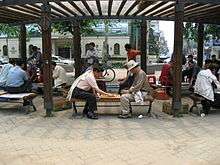
Perhaps one of the unifying features among East Asian countries is the strategy board game of Go (Japanese: 囲碁 igo or 碁 go, Chinese: 圍棋(traditional) / 围棋(simplified) wéiqí, Korean: 바둑 baduk). While Chinese in origin, it is also popular in Japan and Korea. China, Japan, South Korea and Taiwan all have domestic tournaments for their top professional players, and there are also international tournaments for the top domestic players to compete for national glory.
China, Japan and Korea each has its own national variant of chess, which are significantly different from international chess. Chinese xiangqi (象棋) and Korean janggi (장기) share the same origins and as such, are similar to each other, though the rules of the modern games have diverged significantly. On the other hand, Japanese shogi (将棋) hardly resembles any other variant of chess known to exist.
Buy
Every country in East Asia, as well as the Chinese special administrative regions of Hong Kong and Macau issue their own currencies, which are the sole legal tender in each of their respective countries/territories. US dollars and Euros are accepted at most banks and money changers, and are also widely accepted in larger department stores and major tourist attractions, though rates in those areas are usually poor. Other widely accepted currencies at banks and money changers include Swiss francs, British pounds, Australian dollars, Canadian dollars, New Zealand dollars and Singapore dollars.
Costs
China and Mongolia are relatively cheap, but prices are generally expensive elsewhere. Expect the cost of living to be on par with most Western countries in Japan, and only slightly cheaper in South Korea, Taiwan, Macau and Hong Kong.
Tipping
Tipping is very rare generally in East Asia.
Eat
Chopsticks are the main eating utensil of East Asia. Outside of restaurants specializing in Western cuisine, forks are rarely available and knives are not to be used at the table but spoons are available for soup.
Rice is an East Asian staple, although in much of northern China and Mongolia wheat predominates.
Fried rice is another popular dish, prepared in a variety of ways in different regions. Fried rice usually has some combination of eggs, vegetables, meat, and/or seafood fried with the rice. Occasionally, some places have other varieties, such as a fruit fried rice.
Noodles are readily available throughout the region, with Northern China and Japan providing many variations.
If you'd like to sample lots of different street food, East Asia is a good place for this.
Tokyo, Kyoto and Hong Kong are generally regarded as the best cities in the region for fine dining, though Seoul and Taipei are also rapidly catching up.
Western restaurant review web-sites such as Yelp and TripAdvisor are generally unreliable for East Asian countries, as locals often do not post reviews there. Instead, each area typically has its own restaurant review web-site. These are Tabelog for Japan, OpenRice for Hong Kong, iPeen for Taiwan and Dianping for mainland China, the former two of which have English versions available.
Drink
Tea is the quintessential East Asian drink. Generally, green (unfermented) varieties are preferred over Western-style black tea, but the varieties available cover the entire color and taste spectrum. China, in particular, produces a wide variety of tea, ranging from green teas to black teas, and even the same type of tea comes in many different grades. Note that East Asians generally drink their tea neat, so unless you are at a shop which specifically makes milk tea, milk and sugar may not be available except in Mongolia, where milk tea is served with all meals, and Tibet, where yak butter tea is traditional.
Beer is also an important drink, especially in Northeast Asia. There are parts of Northern China where beer is drunk more widely than tea — especially in Qingdao, home to Tsingtao beer — and Kirin and Asahi beer are quite popular in Japan.
Japan is also the home of sake, commonly called rice wine though brewed similarly to beer and with a similar amount of alcohol by volume. Rice wines are also available in other parts of East Asia.
Liquor, such as shochu in Japan or soju in Korea, is very popular throughout most of East Asia. These drinks are ingrained in their cultures, and are an entertaining experience. Korea might be called the "Ireland of the East," given its drinking culture. Beware, however, that the most common victims of crime (what little there is) in Korea and Japan are irresponsible drinkers outside bars. China also has a tradition of drinking rice liquors known as baijiu, which often has higher proof than European liquors such as whisky and vodka (up to 65% alcohol). Chinese baijiu comes in many different styles, some of the more common ones being erguotou and maotai. In Taiwan, the national drink is a variant of baijiu known as kaoliang, which is produced on the island of Kinmen. Legal drinking ages are 20 in Japan and 18 in China, Hong Kong, Taiwan, and South Korea (though note that you already regarded as one year old at birth in South Korea).
Stay healthy
Healthcare systems vary widely from country to country. Japan, South Korea, Taiwan and Hong Kong have modern and well-equipped healthcare systems, with the hygiene levels and standards of treatment in local hospitals being at least on par with Western countries. Macau also has good healthcare facilities for routine consultations, though you may need to be evacuated to Hong Kong if your case requires attention from a specialist or certain specialised medical equipment. Mainland China's healthcare system is much more of a mixed bag. While hospitals with standards of treatment mirroring that of the West exist in major cities, you will generally be paying a steep premium for their services, and the standard of local Chinese hospitals may not be up to what Western visitors are willing to put up with. At the other end of the spectrum, healthcare is North Korea is of a poor standard and close to nonexistent, so you will be better off evacuated to one of the neighbouring countries should a medical emergency arise.
The air quality in the industrial cities of northern China can border range from bad to terrible to outright dangerous. People with serious respiratory problems should seriously consider not traveling there for long periods. Check PM2.5 reading before arrival.
Second-hand smoke is a problem in China with 320 million smokers (over 60% of the adult male population). While few locations ban smoking, second-hand smoke mainly affects travelers on hard seat carriages on slow trains and hole-in-the-wall restaurants.
Stay safe
.jpg)
East Asia is probably one of the safest regions on the planet for travelers, at least when it comes to violent crime and is characterized by stable politics and low crime. The main exceptions are China's restive western territories. Xinjiang has become increasing dangerous with the rise of indiscriminate bombings and stabbings. Be extra careful when in large crowds such as at train stations and markets. Tibet has the occasional risk of ethnic unrest. This tends not to pose much of a threat to international travellers, as foreigners are almost never targeted. The heavy police presence keeps crime low. It is standard practice to block visitor entry at the slightest hint of trouble to China's Tibetan regions or during important dates, so know before you go, or you may be turned away from buying a bus or train ticket and have to reroute your entire trip in sudden frustration.
Large parts of China and especially Japan and Taiwan are at significant risk from earthquakes. If you're indoors and you feel a shake, stay indoors, as running outside during a quake is the most likely way you'll be injured or killed. Extinguish gas burners and candles and beware of falling objects and toppling furniture. Shelter under furniture or a doorway if necessary. If you're outdoors, stay away from brick walls, glass panels and vending machines, and beware of falling objects, telephone cables, etc. Falling roof tiles from older and traditional buildings are particularly dangerous, as they can drop long after the quake has ended.
Many parts of East Asia are mountainous. Use caution when driving or trekking up in these areas. Road safety in mainland China can range from lacking in coastal regions to suicidal in western regions. General rule of thumb is: more remote the region, more reckless the driver. Buses are fairly safe during the day time but not so much at night. Sleeper buses should especially be avoided due to their tendency to self immolate, take a night train instead. Due to lack of law enforcement, self driving in mainland China is not advised. Hire a car with a driver should the need arise.
